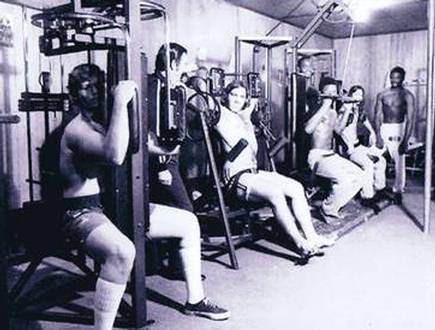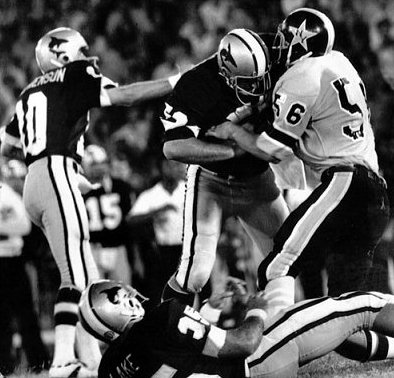

"Quality Of The Game and Butkus III"
HELMET HUT NEWS/REFLECTIONS April 2012:
Quality of the Game and Butkus PART III
By Dr. Ken
With
the
establishment
of
the
short-lived
World
Football
League,
[see
HELMET
HUT
team
summaries
and
helmet
displays
at
http://helmethut.com/WFL/wflindex.html
]
one
of
my
memorable
deliveries
for
Nautilus
Sports/Medical
Industries
occurred
at
the
Gator
Bowl
facility
in
Jacksonville,
Florida.
I
was
dispatched
with
another
driver,
Doug,
to
the
camp
of
the
Jacksonville
Sharks.
The
company,
still
limited
in
personnel
during
what
were
still
the
early
years,
delivered
equipment
in
two,
distinct
manners.
With
only
one
company
owned
tractor
trailer
at
the
time,
we
would
load
thirty-three
to
thirty-five
machines
into
the
trailer,
completely
broken
down,
at
times
to
what
seemed
like
the
smallest
possible
components
in
order
to
maximize
the
number
of
pieces
on
the
load.
As
one
of
only
two
long
haul
drivers,
my
schedule
was
close
to
impossible.
We
would
travel
around
the
nation
and
into
Canada,
delivering,
assembling,
and
installing
the
equipment
and
then
remain
on
site
to
give
instruction
on
what
was
then,
a
brand
new
concept
in
exercise
equipment.
For
smaller
and/or
more
local
packages
of
equipment,
we
would
load
fully
assembled
pieces
into
a
Ryder
twenty-four
foot
rental
truck
and
make
the
deliveries
and
installation
without
necessary
on-site
assembly.
 |
An early-1970’s photo of high school football players training at the Nautilus factory facility in Lake Helen, Fl. Players from DeLand HS as well as Daytona Beach area schools often used the facility, including, as an aging memory recalls, current Atlanta Falcons Head Coach Mike Smith who played at Father Lopez Catholic HS
For those who like the details, our frantic work schedule would find us on the road for ten days to three weeks, back-hauling everything from barbershop equipment to sanitized garbage for the local pig farmers, leaving the trailer at the factory for cleaning and reloading, and the tractor at the mechanic’s shop for a tune-up and any necessary repair work. Within twenty-four to forty-eight hours, we were once again on the road repeating the delivery, assembly, and installation process. Moving equipment of significant weight and dimension was no easy or enjoyable task. Those in the trucking industry know that the commonly seen truck lift gate was first developed in the mid-to-late 1960’s and did not enjoy widespread use immediately. Typically, as it was on the Peterbilt cab-over tractor trailer rig we drove for the company, a long ramp was used to load and unload heavy equipment in the absence of a loading dock. The problem with the delivery of fully assembled equipment prior to the use of lift gates, was the necessity of safely and efficiently moving 1,200 pound machines with poor balance points onto a two or four-wheel dolly, and rolling them up or down the ramp that sat on the tailgate of the truck. This would most often be compounded by the need to then twist and turn the equipment down and through a narrow stairwell for example. The work was fraught with danger and injury. For our Sharks delivery, arrangements were supposedly made to insure that assistance would be available to us so that the delivery of a dozen new pieces of fully assembled equipment went as quickly, efficiently, and safely as possible. Like much associated with the World Football League, our delivery did not come off as promised or expected.
.jpg) |
The Sharks uniform was among the nicest in the new World Football League
We arrived at the Gator Bowl in the Ryder rental truck one late-spring morning in 1974 and drove to the office area of the Sharks. It was less than impressive and looked as if a group of fraternity boys had partied there the night before. Discarded fast food wrappers and empty cups were strewn around the office, the furniture appeared old and worn, and there seemed to be confusion relative to our arrival, delivery, and arranged-for man power assistance. We were eventually guided to an area away from the offices and field, still on the stadium grounds, until we pulled up next to a cinder block building that appeared to be a large storage shed. In front sat three elderly gentlemen who might have been homeless and all of whom were definitely inebriated. I introduced myself and asked the men if they were supposed to be the ones helping us move a dozen very heavy, very large, and very capable of inflicting physical damage machines. They were polite, answered in the affirmative but quickly noted in markedly slurred speech that “we supposed to take some light boxes from a truck to inside.” I knew this was not going to go well and explained that the “light boxes” were in fact, huge half-ton pieces of equipment and all had to be placed on dollies and then rolled down a twelve foot ramp, through the narrow doorway into the shed and placed into position. They did little more than stare and smile at Doug, and me. The shed was just that; dirt floors in each of three moderately sized rooms within a one-hundred percent cinder block and tin roof structure. Lighting consisted of a half dozen bare bulbs hanging from the ceiling. When one of the “office guys” walked over to see if we had begun to unload, I asked, “This is going to be your weight room?” Answering in the affirmative I noted the lack of lighting, lack of ventilation, absence of a sturdy or level floor, and the fact that despite assurances, we would be fortunate to be able to aim two or three of the pieces through the extremely narrow external and internal doorways. I also noted the absence of sufficient help. We were told to “do what you have to” which was echoed by the staff in our home office when we telephoned for advice. The highlight of this specific delivery occurred when a Double Chest Machine sat at the top of the ramp, just off of the tailgate, with all three of the “hired help” holding it in place as Doug and I began to ascend the ramp. In an instant the 36” x 75” x 79” in height, 1260 pound mass of steel and chrome was hurtling towards us. Amid cries of “Oh Lordy!” and “Watch out down there.” Doug and I had to literally leap out of the way to avoid broken bones or death as the machine raced down the ramp and crashed through the cinder block wall. Bricks exploded as the machine settled to a stop, off of the dolly but still miraculously upright. The “explosion” of sound was so great that Sharks Head Coach Bud Asher and other team personnel came sprinting over to our location. They were all sympathetic and agreed to provide payment in the form of the promised case of beer to the three helpers while immediately removing them from the premises. Rather quickly more suitable assistance was provided for us and we continued our work.
 |
Sharks in action vs. New York Stars
The entire incident served to introduce me to Coach Asher with whom I had an immediate rapport. After a few hours of moving and installation, the equipment was in, instruction given to the assistant coach who was to also serve as strength coach, and Asher invited me to sit with him in his office. He brought in lunch, and we talked about football for two or three hours. This eventually led to his invitation for me to give football another shot as a prospective member of the Sharks. With plans to serve as the best man at my brother’s impending wedding and a month off from work, the offer was tempting. Unfortunately, my collegiate playing weight of 232 pounds had presently been reduced to approximately 170, necessitating a change in position from fullback to defensive back and though my entire football history had been played during the two-way era, that defensive position had not brought a great deal of success. Coach Asher handed me a $100.00 dollar bill and a contract, and I was once again, after a brief stint with the Westchester Bulls of the Atlantic Coast Football League six years before, a professional!
Presenting a proper perspective, with the Bulls, I knew the going rate for player contracts in the Atlantic Coast Football League and specifically with the Bulls. With friend Joe Tuths and other local players like former C.W. Post College and Denver Broncos receiver Tom Cassese on the team, I sat across a desk from Bulls General Manager Tom Scott, confident that I would be paid what I thought was a fair salary. Scott, the former N.Y. Giants linebacker, was more than willing to discuss the past glories of the “G-Men” squads I had watched in the early-‘60’s but he wasn’t moved by my familiarity with his playing career nor my request for $200.00 per week. That he offered $75.00 puts my abilities into perspective, and that I accepted it without so much as a whimper is indicative of the self-acceptance of my true standing in the talent hierarchy. The $100.00 bill that Asher took out of his own pocket would be the sum total of my WFL pay. After less than three weeks it was obvious to all I no longer “had it” despite a bit of special, individualized attention from former Kansas City Chiefs great Johnny Robinson who was our defensive backfield coach. I might have deluded myself into thinking that I would have performed up to minimal Sharks standards at my more familiar running back position, but observing former University of Florida’s Tommy Durrance and Georgia’s Ricky Lake, I instinctively knew I was not close to the quality of talent these players possessed. Durrance especially was extremely underrated, a smooth, tough, quick back with great blocking ability who was obviously committed to being the best possible team player. I was reminded that when fans sit in the stands or on the couch in their living room and shout down to the field at a specific player that “You stink!” they have no idea just how good any collegiate or professional player truly is. They may make a bad play or “stink” only relative to others on the field but everyone possesses a great deal of athletic ability and talent, usually in amounts far beyond the understanding of the average fan who at best, toiled on their high school squad. Durrance was exceptional and an example of many WFL players who had inordinate amounts of talent yet could not make an NFL roster.